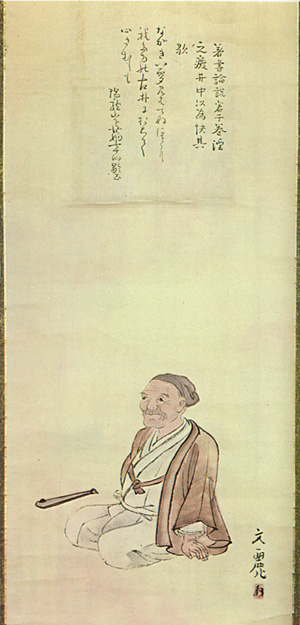Ueda Akinari facts for kids
Ueda Akinari (born July 25, 1734, died August 8, 1809) was a famous Japanese writer, scholar, and poet. He lived in the 18th century and is one of the most important literary figures from that time. He was one of the first writers of a new type of story called yomihon. His two most famous books are Ugetsu Monogatari ("Tales of Rain and the Moon") and Harusame Monogatari ("Tales of Spring Rain"). These books are very important in Japanese literature.
Life Story of Ueda Akinari
When Ueda Akinari was a child, he became very sick with smallpox. He survived, but his fingers were left a bit changed. During his illness, his parents prayed to a god at the Kashima Inari Shrine. Ueda believed that this god helped save his life. Because of this, he always strongly believed in the supernatural. This belief shows up in many of his stories, especially in Ugetsu Monogatari, which is a collection of ghost stories.
Ueda inherited his family's business, which sold oil and paper, after his adoptive father passed away. However, he was not very good at being a merchant. After ten unhappy years, his business was destroyed in a fire. During this time, he wrote several funny stories in a style called ukiyo-zōshi, which means "tales of the floating world."
The fire gave Ueda a chance to leave the business world. He started studying medicine with a teacher named Tsuga Teishō. This teacher also taught him about Chinese stories. In 1776, Ueda began working as a doctor and also published Ugetsu Monogatari. This book made him one of the most important writers of yomihon. Yomihon was a new kind of story that changed how people read popular fiction.
Besides writing stories, Ueda was also involved in a field of study called kokugaku. This was the study of old Japanese language and classic Japanese literature. People who studied kokugaku often wanted to remove foreign influences from Japanese culture, especially from China. This included Chinese language, Buddhism, and Confucianism. Ueda had his own ideas and didn't always agree with others in this group. He had a big debate with a leading scholar named Motoori Norinaga. Some people think Ueda also explored these ideas in his stories, like those in Ugetsu Monogatari. He would start with Chinese ideas but then add Japanese feelings and supernatural elements.
After his wife died in 1798, Ueda temporarily lost his eyesight. Even though he later got some sight back in his left eye, he had to tell others what to write for most of his later works. Around 1802, he started working on his second yomihon book, Harusame Monogatari ("Tales of the Spring Rain"). Harusame is quite different from Ugetsu Monogatari. For example, Harusame does not have supernatural elements, and its stories are of many different lengths. One story in Harusame is called Hankai. It is about a rough man who suddenly decides to become a Buddhist and spends the rest of his life as a monk.
Ueda Akinari passed away in Kyoto in 1809, when he was 76 years old.
Main Books by Ueda Akinari
- Ugetsu Monogatari ("Tales of Rain and the Moon") (1776)
- Harusame Monogatari (春雨物語) (1809)
See also
 In Spanish: Ueda Akinari para niños
In Spanish: Ueda Akinari para niños
- Kyokutei Bakin
- Edo period
- Ugetsu


